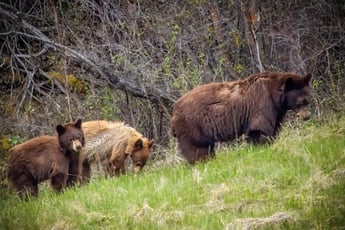Helping Wildlife in the Modern Age

Rick Spitzer

*Text and Photos by Rick Spitzer
For many years deer, elk, and bighorn sheep have moved every winter from the high country of Eagle County into the lower valleys. They have done this for millennia to escape deep snows, find open areas with a good winter food and water supply, and use the open areas for the rut during the mating season.
The south facing slopes tend to be free of snow for much of the winter season. These areas are used by deer and bighorn where they feed on grasses and shrubs. The deer find cover in the brush and bighorn seek protection in the cliffs. Elk tend to find cover in the trees of north facing slopes and move into the meadows to feed on the grasses. All three found open water in these valleys year round. These animals had regular corridors they followed in and out of the valleys in their annual migrations.
Small bands of Native Americans lived in harmony with these ungulates in the valleys of Eagle County for at least 7,000 years. They moved through the area seasonally and had a hunter-gatherer lifestyle. Evidence from archaeological sites which indicate that they hunted these animals include projectile points. The last hunter-gatherer group known to have inhabited this area were the Utes. They were forcibly removed to reservation lands in eastern Utah in 1881, which may have contributed to a shift in the balance of the ecological systems of the area.
Europeans showed up around 150 years ago and began to change the land on a permanent basis. Ranchers and farmers brought in cattle, sheep, and horses that were grazed in these valleys. Planting of hay, potatoes, and lettuce began to replace the native vegetation that was used by deer, elk, and bighorn. Fencing modified the historical migration routes.
The population began to increase and railroads and stage roads were built to make travel easier. As technology improved, the vehicles changed to high speed automobiles making it easy to travel to these areas.

The valley floors of the Gore Creek and Eagle River Valley
are filed with businesses, housing, and roads that occupy space once used
by a variety of wildlife. Housing is also moving up the slopes in the valleys.
Construction of homes, businesses, roads, and parking lots filled the valley floors, the flat areas where it was easy to build. Quarries in the valleys were a source for some of the raw materials needed for construction. Over time, home construction changed as homes were constructed higher on the hillsides. This was partly due to the fact that areas in the valley floor were getting crowded, but also because people wanted the beautiful views. This construction removed the historical use of those higher areas by the ungulates and other wildlife.
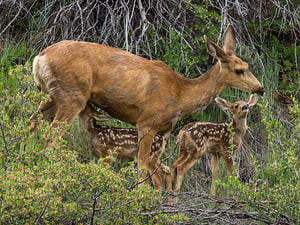
Habitats used by wildlife to survive winters and raise their young is disappearing in Eagle County.
Cars collided with animals on the roadways causing property damage, injuries, and even deaths. Fencing was built along the roads to reduce those issues, but that fencing blocked the corridors that many of the animals used for migration.
Improvements in technology now also allow recreation year round. Clothing, gear, and vehicles changed the way people used the environment, and all the recreational activity brought more people here to enjoy the natural beauty and recreation of the area. However, as recreation and development increase, the impact on wildlife increases too.
As residents of this area, we are all contributing to this dilemma, in big or small ways.
However, there are many ways to help alleviate these pressures on wildlife. What can be done?
Fencing along the highways has been successfully mitigated with wildlife overpasses and tunnels. Summit County has constructed those interventions on Highway 9 north of Silverthorne. That will not work in some areas of Eagle County. Building overpasses and tunnels that lead to housing areas accomplishes nothing. Eagle County is considering similar things on I-70.
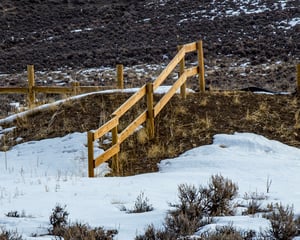 Wildlife fencing protects vehicles and the people in them from wildlife collisions,
Wildlife fencing protects vehicles and the people in them from wildlife collisions,
but it also blocks migration corridors in the valley.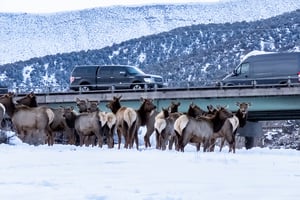
Deer and elk often get trapped behind highways and fencing that is now in areas they have used historically.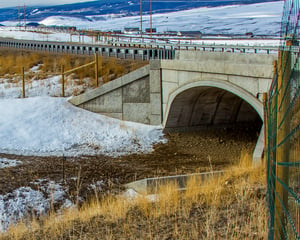
Overpasses and underpasses, like this one on Highway 9 north of Silverthorne,
can help wildlife move through areas that have been blocked by roads and fencing.
Towns and the county can implement smart building practices that would require some open, unmodified areas for the wildlife. Corridors for wildlife movement should be maintained. Closures during some areas during certain seasons like the rut in the fall and birthing in the spring would allow the animals to maintain their current populations. Restrictive covenants, zoning, and comprehensive planning processes can also provide for landscape scale protections.
Some residents feed the wildlife and put out salt blocks in their yards to attract wildlife. Although those intentions are good, in actuality, it can change the length of time the wildlife spends in their historical habitat which can be detrimental to the habitat, and attract bears to residential areas.
A variety of habitats such as riparian areas, wetlands, and grasslands can be placed into conservation easements to maintain those habitats undisturbed. This also prevents development pressure and escalating bills from forcing landowners to subdivide and sell their land. This helps keep the land in agricultural production and provides habitat for fish and wildlife.
What can you do?
• Support Town and County efforts to revise land use planning procedures to incorporate smart building practices and maintenance of wildlife corridors
• Adhere to seasonal closures of trails and recreation areas and always stay on the trail
• Volunteer as a trail ambassador to educate the public about seasonal closures and how they can minimize their impacts
• Plant native grasses and flowers and do not use pesticides in your yard
• Contribute to the Eagle Valley Land Trust if you'd like to participate in conservation easement protection
Thank you for taking action to maintain a healthy wildlife population in our valley!
The Eagle County Community Wildlife Roundtable is a collaborative partnership with the White River National Forest, Colorado Parks and Wildlife, Bureau of Land Management, local government entities, community members, and citizen scientists. The purpose of the Eagle County Community Wildlife Roundtable is to gather a group of diverse stakeholders in the valley to understand and address issues facing wildlife populations. Together we will identify a shared vision and realistic actions that the community can rally around to support wildlife. We want to leverage diverse values, creativity, and resources to move toward positive action.

Rick Spitzer
Rick Spitzer is the author of the article and official photographer for Eagle County Community Wildlife Roundtable.
Blog posts
Related Articles.
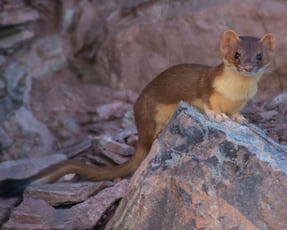

Rick Spitzer
We have an Impact on Ecosystems, but Not in a Good Way
Ecosystems are biological communities which consist of many organisms interacting in a specific...

